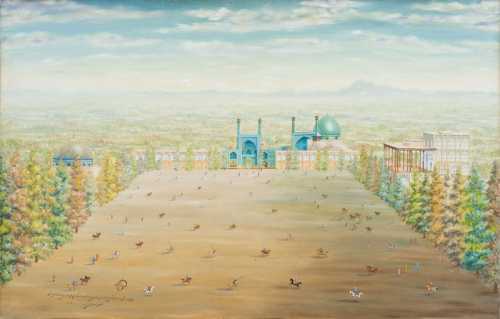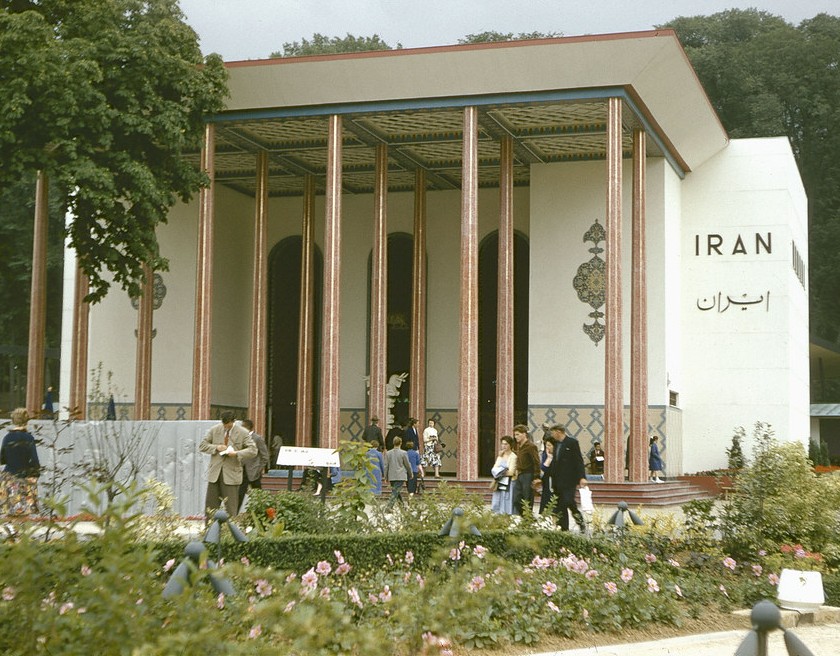About Mohammad Hossein Mosavvar Ol Molki
Mohammad Hossein Mosavvar Ol Molki known as Haj "Mosavvar Ol Molki" was born in Isfahan in 1890. His ancestors were all painters until the Safavid period. He first learned the basics of painting from his father, and after his death, he turned to pencil box painting for a living. In addition, he was skilled in carpet design, Tash'ir and coffee house painting, but his fame outside of Iran is mostly due to his paintings.
At first, he was attracted to the works of Kamal aldin Behzad, and then he became interested in the style of Reza Abbasi. In his middle age, he traveled to Paris with the aim of connecting Iranian painting with Western painting, and the turning point of this trip was his acquaintance with Arthur Upham Pope, a famous Iranologist. The result of this familiarity was the preparation of plant motifs of exquisite Iranian carpets by Mosavvar Ol Molki for one of Pope's books. He returned to Iran after a few months.
The first experience of Mohammad Hossein Mosavvar Ol Molki in the art world was the London International Exhibition. In this exhibition, he managed to receive a special medal of George V from the Queen of England with a painting depicting worshipers in the mosque. Also, his painting "Persepolis" won the gold medal at the Brussels International Exhibition in 1958 (1336). In recent years, his work "Isfahan's Naqsh-e-Jahan Square" was sold at the price of 16,730 dollars in the 11th Tehran auction.
Another painting by him called "Axis Defeat" depicts the defeat of the Allies in World War II. In creating this work, he takes inspiration from the story of the battle between Iranians and Turanians in Ferdowsi's Shahnameh and gives it an Iranian identity, so that poems from this story appear in the form of Tash'ir in the margins of this work. This painting attracted the attention of the leaders of the allies to the extent that it caused them to officially appreciate Mosavvar Ol Molki. Among the most famous works ofMosavvar Ol Molki, we can mention "Imaginary Mosque", "Nader Shah Afshar's War with Mohammad Shah Handi", "Sheikh Sanan and Christian maiden" and "Polo match".
Due to his family background and familiarity with Safavid art, he was one of the restorers of Chehel sotoun Palace paintings in the 40s. Mohammad Hossein Mosavvar Ol Molki died in 1977 and his house in Isfahan was turned into a museum.
At first, he was attracted to the works of Kamal aldin Behzad, and then he became interested in the style of Reza Abbasi. In his middle age, he traveled to Paris with the aim of connecting Iranian painting with Western painting, and the turning point of this trip was his acquaintance with Arthur Upham Pope, a famous Iranologist. The result of this familiarity was the preparation of plant motifs of exquisite Iranian carpets by Mosavvar Ol Molki for one of Pope's books. He returned to Iran after a few months.
The first experience of Mohammad Hossein Mosavvar Ol Molki in the art world was the London International Exhibition. In this exhibition, he managed to receive a special medal of George V from the Queen of England with a painting depicting worshipers in the mosque. Also, his painting "Persepolis" won the gold medal at the Brussels International Exhibition in 1958 (1336). In recent years, his work "Isfahan's Naqsh-e-Jahan Square" was sold at the price of 16,730 dollars in the 11th Tehran auction.
Another painting by him called "Axis Defeat" depicts the defeat of the Allies in World War II. In creating this work, he takes inspiration from the story of the battle between Iranians and Turanians in Ferdowsi's Shahnameh and gives it an Iranian identity, so that poems from this story appear in the form of Tash'ir in the margins of this work. This painting attracted the attention of the leaders of the allies to the extent that it caused them to officially appreciate Mosavvar Ol Molki. Among the most famous works ofMosavvar Ol Molki, we can mention "Imaginary Mosque", "Nader Shah Afshar's War with Mohammad Shah Handi", "Sheikh Sanan and Christian maiden" and "Polo match".
Due to his family background and familiarity with Safavid art, he was one of the restorers of Chehel sotoun Palace paintings in the 40s. Mohammad Hossein Mosavvar Ol Molki died in 1977 and his house in Isfahan was turned into a museum.
The Most Expensive Artwork
At Auctions
First Attendance
28 October 2007
# Attendance
3
# Artworks
3
Average Realized Price
7,207 USD
Average Min Estimate
9,193 USD
Average Max Estimate
13,789 USD
Sell-through Rate
100%
Average Growth of Artwork Worth
194%
Timeline
یازدهمین دوره حراج تهران auction
5 July
Islamic and Indian Art auction
9 June
Articles
The history of world's fairs and the presence of Iran 21 May 2023
In this essay, the history of world's fairs is discussed, and then the world's fairs in which Iran has participated are mentioned. In these exhibitions, each country had a booth, and Iran presented Iranian commercial products and cultural works of art in it. Among these products, we can mention handicrafts such as carpets and Qalamkar fabrics; Also, paintings by prominent artists we...

